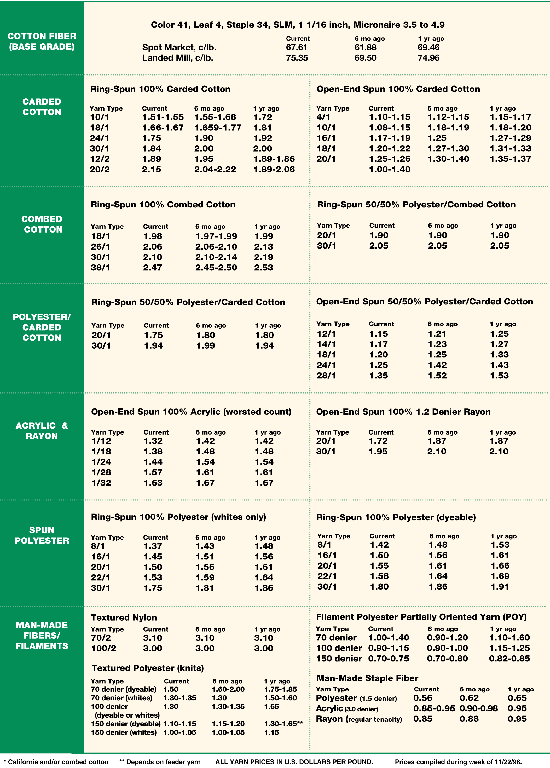Experts in the cotton market are at a loss to explain why the price of cotton continues to
decrease.
According to one respondent with experience in this field, cotton prices have droppedslightly over 11 cents since mid-August, setting a new season low of 63.14 cents in mid-November.
“The experts have been saying for several months now that prices will go up,” he said. “Shows you how much the experts know. A lot of the blame is put on a farm program, which has gone
awry. Step two of that program goes out the first of the year, so if prices begin to go up during the first quarter, it may prove the experts right. Of course, cotton merchants are not bidding up
cotton this year and many growers are holding back their crop for higher anticipated prices.”
Several spinners also commented on this subject. One had an unusual observation concerning the exporting of cotton. He said that it would be possible for an offshore company to buy domestic cotton for resale, at a profit, to a domestic producer. That would be an interesting topic for
Congress to explore.
Speaking of Congress, one spinner wants to know what his representatives are doing.
“Where are our friends in Washington?” he asked. “Do they still exist? Generally, imports are worse this year than ever (from the aspect of a threat to spinners) and there is no interest at all in Washington. More knitting machines are standing today than ever in my experience in this industry. This makes for a glut of open-end yarns, and I see no encouraging signs for that segment
of the textile market.”
Spinners And Pricing
Pricing is, of course, still uppermost in the minds of any cotton-mill man.
According to one spinner: “I can’t recall when pricing for open-end yarns has been so erratic. It has no direction at all. There is no price structure and I couldn’t sell a pound of yarn at the prices I quoted. We screwed it up ourselves, and imports just make it worse.”
Another spinner seconded this comment by saying: “Pricing is ridiculous. We are selling yarn at virtually the same price as cotton. It’s crazy, and it’s not the customers’ fault. When he comes to you asking for a quote, you give him the asking price and he says, ‘Well I can get it from so-and-so for twenty cents less.’ If you come down, who is setting the price? I say it is not the customer but the industry.”
“Years ago I sold mop yarn for the prices we are now asking for quality apparel yarn,” he added. “It has gotten to the point that some spinners are offering yarn at low prices to customers who are using only 5,000 to 15,000 pounds a week — not enough to justify a large quantity discount. We had a visit from a customer last week who commented that he thought prices in the market were crazy. The problem is that our knitter customers get accustomed to unrealistically low prices and so do their customers. When the time comes to increase prices, it is hard to explain the reasons
behind it.”
He also observed that it is even more difficult for the knitter to explain it to his customer. There are reports of 18/1 open-end carded cotton yarn being sold as low as 92 cents per pound.
The lack of cold weather is to blame for some of the problems in open-end yarn sales. No one is buying sweaters, long-sleeve T-shirts or jogging pullovers. Even jeans sales are off. Weather is a major player according to spinners.
Spinners report that the weaving business is better than knitting. Not all segments of weaving are active, however. The weaving apparel trade is not good, but home furnishings and industrial segments are much more active. Business in these areas is also more consistent.
Survival
Synthetic spinners report that their markets are weak but add that this is the traditionally slow period for them.
“We are not curtailing, but markets are weak,” said a spinner in this field. “You will remember that last year we broke with tradition and had strong year-end business followed by a weak first quarter. This year I feel we are going to have a struggle during the first quarter in
addition to having a weak fourth quarter. People seem to be buying, but it is all imports. Asian market conditions are partly to blame. We’ll survive though.”

January 1999




